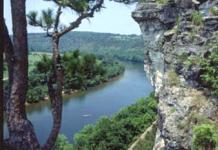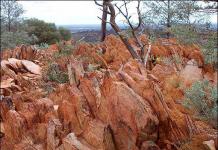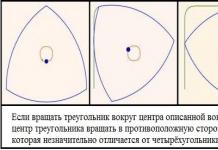DEFINITION
Alcanami are called saturated hydrocarbons, the molecules of which are composed of carbon and hydrogen atoms, linked to each other only by σ-bonds.
Under normal conditions (at 25 o C and atmospheric pressure) the first four members of the homologous series of alkanes (C 1 - C 4) are gases. Normal alkanes from pentane to heptadecane (C 5 - C 17) are liquids, starting from C 18 and above are solids. As the relative molecular weight increases, the boiling and melting points of alkanes increase. With the same number of carbon atoms in the molecule, branched alkanes have lower boiling points than normal alkanes. The structure of the alkane molecule for the example of methane is shown in Fig. 1.
Rice. 1. The structure of the methane molecule.
Alkanes are practically insoluble in water, since their molecules are low-polarity and do not interact with water molecules. Liquid alkanes mix easily with each other. They dissolve well in non-polar organic solvents such as benzene, carbon tetrachloride, diethyl ether, etc.
Getting alkanes
The main sources of various saturated hydrocarbons containing up to 40 carbon atoms are oil and natural gas. Alkanes with a small number of carbon atoms (1-10) can be isolated by fractional distillation of natural gas or petroleum gasoline fraction.
There are industrial (I) and laboratory (II) methods for producing alkanes.
C + H 2 → CH 4 (kat = Ni, t 0);
CO + 3H 2 → CH 4 + H 2 O (kat = Ni, t 0 = 200 - 300);
CO 2 + 4H 2 → CH 4 + 2H 2 O (kat, t 0).
- hydrogenation of unsaturated hydrocarbons
CH 3 -CH = CH 2 + H 2 → CH 3 -CH 2 -CH 3 (kat = Ni, t 0);
- reduction of haloalkanes
C 2 H 5 I + HI → C 2 H 6 + I 2 (t 0);
- reactions of alkaline melting of salts of monobasic organic acids
C 2 H 5 -COONa + NaOH → C 2 H 6 + Na 2 CO 3 (t 0);
- interaction of haloalkanes with metallic sodium (Wurtz reaction)
2C 2 H 5 Br + 2Na → CH 3 —CH 2 —CH 2 —CH 3 + 2NaBr;
- electrolysis of salts of monobasic organic acids
2C 2 H 5 COONa + 2H 2 O → H 2 + 2NaOH + C 4 H 10 + 2CO 2;
K (-): 2H 2 O + 2e → H 2 + 2OH -;
A (+): 2C 2 H 5 COO - -2e → 2C 2 H 5 COO + → 2C 2 H 5 + + 2CO 2.
Chemical properties of alkanes
Alkanes are among the least reactive organic compounds due to their structure.
Alkanes under normal conditions do not react with concentrated acids, molten and concentrated alkalis, alkali metals, halogens (except for fluorine), potassium permanganate and potassium dichromate in an acidic environment.
For alkanes, reactions proceeding according to a radical mechanism are most characteristic. Homolytic rupture is energetically more favorable bonds C-H and C-C than their heterolytic gap.
The reactions of radical substitution most easily proceed through the tertiary, and more easily through the secondary and, last of all, through the primary carbon atom.
All chemical transformations of alkanes proceed with cleavage:
1) C-H connections
- halogenation (S R)
CH 4 + Cl 2 → CH 3 Cl + HCl ( hv);
CH 3 -CH 2 -CH 3 + Br 2 → CH 3 -CHBr-CH 3 + HBr ( hv).
- nitration (S R)
CH 3 -C (CH 3) H-CH 3 + HONO 2 (dilute) → CH 3 -C (NO 2) H-CH 3 + H 2 O (t 0).
- sulfochlorination (S R)
R-H + SO 2 + Cl 2 → RSO 2 Cl + HCl ( hv).
- dehydrogenation
CH 3 -CH 3 → CH 2 = CH 2 + H 2 (kat = Ni, t 0).
- dehydrocyclization
CH 3 (CH 2) 4 CH 3 → C 6 H 6 + 4H 2 (kat = Cr 2 O 3, t 0).
2) C-H and C-C bonds
- isomerization (intramolecular rearrangement)
CH 3 -CH 2 -CH 2 -CH 3 → CH 3 -C (CH 3) H-CH 3 (kat = AlCl 3, t 0).
- oxidation
2CH 3 -CH 2 -CH 2 -CH 3 + 5O 2 → 4CH 3 COOH + 2H 2 O (t 0, p);
C n H 2n + 2 + (1.5n + 0.5) O 2 → nCO 2 + (n + 1) H 2 O (t 0).
Application of alkanes
Alkanes have found applications in various industries. Let us consider in more detail, using the example of some representatives of the homologous series, as well as mixtures of alkanes.
Methane is the raw material basis for the most important chemical industrial processes for the production of carbon and hydrogen, acetylene, oxygen-containing organic compounds - alcohols, aldehydes, acids. Propane is used as a vehicle fuel. Butane is used to produce butadiene, which is a raw material for the production of synthetic rubber.
A mixture of liquid and solid alkanes up to C 25, called petroleum jelly, is used in medicine as a base for ointments. A mixture of solid C 18 - C 25 alkanes (paraffin) is used to impregnate various materials (paper, fabric, wood) to make them hydrophobic, i.e. non-wetting with water. In medicine, it is used for physiotherapeutic procedures (paraffin therapy).
Examples of problem solving
EXAMPLE 1
| Exercise | The chlorination of methane yielded 1.54 g of a compound, the air vapor density of which was 5.31. Calculate the mass of manganese dioxide MnO 2 that will be required to obtain chlorine if the ratio of volumes of methane and chlorine introduced into the reaction is 1: 2. |
| Solution | The ratio of the mass of a given gas to the mass of another gas taken in the same volume, at the same temperature and the same pressure, is called the relative density of the first gas over the second. This value shows how many times the first gas is heavier or lighter than the second gas. Relative molecular weight air is taken equal to 29 (taking into account the content of nitrogen, oxygen and other gases in the air). It should be noted that the concept of "relative molecular weight of air" is used conventionally, since air is a mixture of gases. Find molar mass gas generated during the chlorination of methane: M gas = 29 × D air (gas) = 29 × 5.31 = 154 g / mol. This is carbon tetrachloride - CCl 4. Let's write down the reaction equation and arrange the stoichiometric coefficients: CH 4 + 4Cl 2 = CCl 4 + 4HCl. Let's calculate the amount of carbon tetrachloride substance: n (CCl 4) = m (CCl 4) / M (CCl 4); n (CCl 4) = 1.54 / 154 = 0.01 mol. According to the reaction equation n (CCl 4): n (CH 4) = 1: 1, which means n (CH 4) = n (CCl 4) = 0.01 mol. Then, the amount of chlorine substance should be equal to n (Cl 2) = 2 × 4 n (CH 4), i.e. n (Cl 2) = 8 × 0.01 = 0.08 mol. Let's write the equation for the reaction of obtaining chlorine: MnO 2 + 4HCl = MnCl 2 + Cl 2 + 2H 2 O. The number of mol of manganese dioxide is 0.08 mol, because n (Cl 2): n (MnO 2) = 1: 1. Find the mass of manganese dioxide: m (MnO 2) = n (MnO 2) × M (MnO 2); M (MnO 2) = Ar (Mn) + 2 × Ar (O) = 55 + 2 × 16 = 87 g / mol; m (MnO 2) = 0.08 × 87 = 10.4 g. |
| Answer | The mass of manganese dioxide is 10.4 g. |
EXAMPLE 2
| Exercise | Install molecular formula trichloroalkane, mass fraction chlorine in which is 72.20%. Make up the structural formulas of all possible isomers and name the substances according to the IUPAC substituent nomenclature. | ||||||||||||||||
| Answer | Let's write down the general formula for trichloroalkane: C n H 2 n -1 Cl 3. According to the formula ω (Cl) = 3 × Ar (Cl) / Mr (C n H 2 n -1 Cl 3) × 100% calculate the molecular weight of trichloroalkane: Mr (C n H 2 n -1 Cl 3) = 3 × 35.5 / 72.20 × 100% = 147.5. Find the value n: 12n + 2n - 1 + 35.5 x 3 = 147.5; Therefore, the formula for trichloroalkane is C 3 H 5 Cl 3. Let's compose the structural formulas of the isomers: 1,2,3-trichloropropane (1), 1,1,2-trichloropropane (2), 1,1,3-trichloropropane (3), 1,1,1-trichloropropane (4) and 1 , 2,2-trichloropropane (5). CH 2 Cl-CHCl-CH 2 Cl (1); CHCl 2 -CHCl-CH 3 (2); CHCl 2 -CH 2 -CH 2 Cl (3); CCl 3 -CH 2 -CH 3 (4); Chemistry lessons in grade 10 according to the two-hour program Gabrielyana O.S. A.V. Abbakumov Lesson “Natural gas. Alkanes ". (lecture)
Lecture plan.
1. Natural gases and their uses. Our country ranks first in the world in terms of natural gas reserves. About 200 natural gas fields have been discovered in Russia. The vast majority of the produced gas is used as fuel. Gas advantages over other fuels:
Thus, natural gas today is one of the best views fuels for domestic and industrial (automobiles, metallurgical, glass and soap-making furnaces and others). In addition, natural gas serves as a valuable and cheap raw material for the chemical industry. The composition of natural gas from different fields is different. However, gases from all fields contain hydrocarbons with a low relative molecular weight. Natural gas composition:
2. The concept of hydrocarbons. The name of the group of organic compounds that we are starting to study today reflects their composition. Hydrocarbons are compounds consisting only of carbon and hydrogen atoms. Hydrocarbons
Cyclic (carbocyclic) Acyclic Cyclic (carbocyclic) compounds are compounds that contain one or more rings containing only carbon atoms. They, in turn, are divided into aromatic and non-aromatic. Acyclic hydrocarbons include organic compounds, the carbon skeleton of molecules of which are open chains. These chains can be formed by single bonds (alkanes), contain one double bond (alkenes), two double bonds (dienes), one triple bond (alkynes). Today we are starting to study the first class of hydrocarbons - alkanes (saturated, saturated, paraffinic hydrocarbons). ^ Alkanes are hydrocarbons in whose molecules the atoms are linked by single bonds and which correspond to the general formula C n H 2 n +2 . [ Demonstration of the relationship of methane to a solution of potassium permanganate and bromine water]. The simplest representative of this class, methane, has been known to people for a very long time. It was called marsh or mine gas. The carbon atom in methane is in the sp 3 -hybridization state. In this case, carbon has four equivalent hybrid orbitals, the axes of which are directed towards the vertices of the tetrahedron. The angle between the axes of these orbitals is 109 ° 28 ". / Image the structure of the carbon atom in sp 3 -hybrid state /. The electronic structure of the carbon atom determines the spatial arrangement of atoms in the methane molecule. All four covalent bonds C - H are formed due to the overlap of the sp 3 -orbitals of the carbon atom and the s-orbital of hydrogen. All bonds in the methane molecule are of the σ-type. The centers of the nuclei of hydrogen atoms lie at the vertices of a regular tetrahedron. / Demonstration of the methane molecule model / . Almost free rotation is possible around a single carbon-carbon bond, and alkane molecules can acquire a wide variety of shapes. / Demonstration on a model of a molecule of butane / . Carbon-carbon bonds are non-polar and poorly polarizable. The length of the C - C bond in alkanes is 0.154 nm. The C - H bond is weakly polar. The absence of polar bonds in the molecules of saturated hydrocarbons leads to the fact that they are poorly soluble in water. Saturated hydrocarbons make up the homologous series of methane. The homologous series is a set of organic compounds with a similar structure and properties and differing from each other in composition by one or more groups - CH 2 - (homologous difference). Representatives of one homologous series are called homologues. Using the first four representatives as an example, deduce the general formula for alkanes: Methane - CH 4; Ethane - C 2 H 6; Propane - C 3 H 8; Butane - C 4 H 10; Pentane - C 5 H 12. (The general formula for alkanes is C n H 2 n +2). Alkanes are characterized by structural isomerism. Structural isomers differ from each other in the structure of the carbon skeleton.
Depending on the number of radicals connected to a carbon atom, they are distinguished: primary, secondary, tertiary and quaternary carbon atoms.
1). Combustion reaction. Numerous chemical reactions flow both around the person and in him. Sometimes we just don't pay attention to these chemical phenomena. When we light gas in the kitchen or flick a lighter, drive a car or watch the tragic consequences of an explosion in a mine on TV, we witness the reaction of alkanes burning [Demonstration of burning methane]. Like most organic matter, saturated hydrocarbons during combustion form water vapor and carbon dioxide: CH 4 + 2O 2 → CO 2 + 2H 2 O When saturated hydrocarbons burn, a large amount of heat is released, which predetermines their use as a fuel. Remember the structure of methane. Carbon atoms have completely exhausted their valence capabilities. To get another substance from methane, you need to break the C - H bonds and replace hydrogen with another atom or group of atoms. Thus, substitution reactions are characteristic of alkanes. ׀ ׀ H − C − H + Cl − Cl → H − C − Cl + H − Cl With a sufficient amount of halogen, the reaction continues until polysubstituted products are formed. Only chlorine and bromine can be used as halogen in such reactions. The reaction with fluorine proceeds with an explosion and leads to the destruction of the alkane molecule, and iodine, as a less active halogen, is not capable of such a transformation. When alkanes are heated without access to air, a wide variety of transformations used in industry occur with it. When methane is heated to 1000 ° C, methane pyrolysis begins - decomposition into simple substances. CH 4 2CH 4 Thus, hydrocarbons with double and triple bonds can be obtained from paraffins. 4). Dehydrogenation reaction. Another practically important process is possible for methane homologues: the dehydrogenation reaction. This transformation takes place in the presence of a catalyst at elevated temperature and leads to the formation of ethylene hydrocarbons. Н − С − С − Н ׀ ׀ It should be noted that at room temperature, saturated hydrocarbons are very inert compounds that do not interact with aggressive substances. The reactions of radical substitution (halogenation, nitration) are most typical for alkanes. Just as the structure of a substance determines its reactivity, so the properties largely determine the field of application of the compounds. Gaseous alkanes are not only household and industrial fuels, but also raw materials for the chemical industry. From them halogen derivatives are obtained, including completely fluorinated hydrocarbons (freons), which are refrigerants for household and industrial refrigerators and air conditioners. Ethane and propane produce unsaturated hydrocarbons and further polymeric materials. Liquid hydrocarbons are, first of all, fuel for engines of various types (a supersonic aircraft consumes up to 100 liters of kerosene per minute!), Solvents, raw materials for producing alkenes. III. Home assignment:§ 3 exercise. 4 I approve: Deputy Director G.G. Ismagulova Group: 5 Date: 23.01.2017 Theme: Alkanes. Homologous series, isomers. Alkane nomenclature. The structure of alkanes. Being in nature and obtaining alkanes. Properties of alkanes. Goals: - to form the ability to draw up structural formulas of organic compounds, using a construction algorithm, to establish causal relationships between the composition, structure and use of substances; To improve the skills of using the IUPAC nomenclature in relation to alkanes; To acquaint students with the isomerism of the limiting HC, their physical properties and the main methods of obtaining. Lesson type: a lesson in the assimilation of new knowledge. Equipment and reagents: ball-and-stick and volumetric models of alkane molecules, paraffin samples, liquid alkanes (pentane, hexane) gasoline, During the classes І. Organizing time. ІІ. Updating knowledge and skills. Homework check. Frontal survey of the class on the theory of the structure of organic matter A.M. Butlerov Substances are divided into two large groups. Which? (organic and inorganic) Does the composition of organic compounds include an atom? (carbon) Organic chemistry is ………… ..? (chemistry of hydrocarbons and their derivatives) Sources of organic matter? (divided into two large groups - natural and synthetic) What are natural organic compounds and synthetic organic substances? (natural gas, oil, coal, peat, oil shale, ozokerite, forestry products, cotton, food Agriculture etc.), (obtained artificially, by organic synthesis) The main provisions of the theory of chemical structure A.M. Butlerov. What are called isomers? The ancestor of all organic compounds are? (hydrocarbons) What compounds are called hydrocarbons and what types of them do you know? Aliphatic hydrocarbons are saturated and unsaturated. What are saturated and unsaturated hydrocarbons? III... Learning new material. Alcanes - saturated hydrocarbons, in the molecules of which carbon atoms are connected to each other only by a single sigma bond and which have the general formula: CnH2n + 2. Alkanes are called paraffins, or hydrocarbons of the methane series. The first member of alkanes is methane, which is why they are called methane hydrocarbons. Alkanes are saturated hydrocarbons and contain as many hydrogen atoms as possible. Each carbon atom in alkane molecules is in a state of sp3 hybridization - all 4 hybrid orbitals of the C atom are equal in shape and energy, 4 electronic clouds directed to the vertices of the tetrahedron at angles of 109 ° 28 ". Due to single bonds between the C atoms, free rotation around the carbon bond is possible. The type of carbon bond is σ-bonds, the bonds are low-polarity and poorly polarizable. The length of the carbon bond is 0.154 nm. The simplest representative of the class is methane (CH4).
According to the IUPAC nomenclature, the names of alkanes are formed using the suffix -an by adding to the corresponding root from the name of the hydrocarbon. The longest unbranched hydrocarbon chain is chosen so that the largest number of substituents has the minimum number in the chain. In the name of the compound, the number indicates the number of the carbon atom at which the substituent group or heteroatom is located, then the name of the group or heteroatom and the name of the main chain. If the groups are repeated, then the numbers indicating their position are listed, and the number of identical groups is indicated by the prefixes di-, tri-, tetra-. If the groups are not the same, then their names are listed in alphabetical order. Alkane names. The word "alkane" is of the same origin as "alcohol". The outdated term "paraffin" comes from the Latin parum - little, little, and affinis - related; paraffins have little reactivity in relation to most chemicals. Many paraffins are homologous; in the homologous series of alkanes, each subsequent member differs from the previous one by one methylene group CH 2. The term comes from the Greek homologos - appropriate, similar. Homologues- substances having the same general formula, similar in chemical properties, but differing from each other in molecular composition by one or more groups of CH 2 atoms, which are called homologous difference. Isomerism of alkanes. Isomerism- substances that have the same molecular composition (i.e. the same molecular formula), but different chemical structure and therefore possessing different properties. Such compounds are called isomers. Structural isomerism is characteristic. In the formula of the alkane molecule, the main chain is chosen - the longest. H3C-CH2-CH2-CH-CH2-CH3 2) Then this chain is numbered from the end to which the substituent (radical) is located closer. If there are several substituents, then proceed so that the numbers indicating their position are the smallest. The substitutes are listed alphabetically. H3C-CH-CH2-CH-CH2-CH3 The hydrocarbon is called in this order: first, the location of the substituent is indicated (in number), then this substituent (radical) is called, and at the end the name of the main (longest) chain is added. Thus, the hydrocarbon can be named: 2-methyl-4-ethylheptane (but not 6-methyl-4-ethylheptane). The names of the radicals are derived from the names of the corresponding hydrocarbons by replacing the suffix - an with - il.
Receiving Methods for extracting them from natural raw materials.
"Synthetic methods for producing alkanes"
Physical properties
The first four members of alkanes are gases, ranging from pentane to pentadecane (C 15 H 32) - liquids, high molecular weight alkanes, which contain 16 or more carbon atoms, - solids. At normal temperatures and with increasing pressure, propane and butane can be found in liquid state... The boiling and melting points of normal alkanes are higher than the boiling and melting points of the corresponding branched alkanes. Alkanes are non-polar compounds. They are lighter than water, do not mix with water (do not dissolve in water) and do not dissolve in other polar solvents. Liquid alkanes are good solvents and are used as solvents for many organic substances. Methane and ethane, as well as high-molecular-weight alkanes, are odorless, but some medium-sized representatives have a peculiar odor. Alkanes are flammable compounds. Chemical properties Substitution reaction: Halogenation: CH 4 + Cl 2 → CH 3 Cl + HCl (chloromethane) CH 3 Cl + Cl 2 → CH 2 Cl 2 + HCl (dichloromethane) CH 2 Cl 2 + Cl 2 → CHCl 3 + HCl (trichloromethane) CHCl 3 + Cl 2 → CCl 4 + HCl (carbon tetrachloride). Nitration reaction: C 2 H 6 + HNO 3 → C 2 H 5 NO 2 + H 2 O Decomposition reactions: CH 4 → C + 2H 2, 2CH 4 → C 2 H 2 + 3H 2 Oxidation reactions: СН 4 + 2О 2 → СО 2 + 2Н 2 О 2СН 4 + О 2 → 2СО + 4Н 2 Catalytic oxidation methane leads to the formation of important oxygen-containing organic compounds. 2CH 4 + O 2 = 2CH 3 OH Application
IV. Pinning a topic Write down the alkane formulas from the formulas of the hydrocarbons below: C 2 H 4, C 3 H 8, C 4 H 6, C 5 H 12, C 6 H 6, C 7 H 16. Name them. (Page 57 task 3) Write, supplementing the carbon skeleton with hydrogen atoms, the complete structural formulas of the following hydrocarbons. Name them. (p. 57 rear 6) Write down the structural formulas of the following alkanes: a) n - pentane; b) 2 - methylbutane; c) 2,4 - dimethylpentane; d) 3 - methyl - 4 - ethylhexane; e) trimethylmethane (p. 57, problem 9) Write down the structural formulas of the following substances: a) 2,3 - dimethylbutane, b) 2,4 - dimethyl - 3 - ethylpentane c) n - pentane V. Lesson summary What's new in the lesson learned? What was interesting? VІ . Homework Paragraph 2.1, 2.2, 2.3, 2.4 write a mini-report on methane and ethane Alkanes- saturated (saturated) hydrocarbons. Methane ( CH 4). All subsequent saturated hydrocarbons differ by CH 2- a group that is called a homologous group, and compounds are called homologues. General formula - WITHnH 2 n +2 . The structure of alkanes.Each carbon atom is in sp 3- hybridization, forms 4 σ - connections (1 C-C and 3 C-H). The molecule is in the form of a tetrahedron with an angle of 109.5 °. The bond is formed by overlapping hybrid orbitals, with the maximum overlap region lying in space on the straight line connecting the atomic nuclei. This is the most effective overlap, so the σ bond is considered the strongest. Isomerism of alkanes.For alkanes isomerism of the carbon skeleton is inherent. Limit joints can take various geometric shapes while maintaining the angle between the bonds. For example,
Various provisions carbon chain are called conformations. V normal conditions conformations of alkanes freely pass into each other by rotation C-C ties therefore they are often referred to as rotational isomers. There are 2 main conformations - "inhibited" and "obscured":
Isomerism of the carbon skeleton of alkanes.The number of isomers increases with the growth of the carbon chain. For example, butane has 2 known isomers:
For pentane - 3, for heptane - 9, etc. If the molecule alkane subtract one proton (hydrogen atom), you get a radical: Physical properties of alkanes.Under normal conditions - C 1 -C 4- gases , C 5 -C 17- liquids, and hydrocarbons with more than 18 carbon atoms are solids. As the chain grows, the boiling point and melting point increases. Branched alkanes have lower boiling points than normal. Alkanes insoluble in water, but readily soluble in non-polar organic solvents. Easily mix with each other. Getting alkanes.Synthetic methods for producing alkanes: 1. From unsaturated hydrocarbons - the "hydrogenation" reaction proceeds under the influence of a catalyst (nickel, platinum) and at a temperature:
2. From halogen derivatives - Wurtz reaction: interaction of monohalogenoalkanes with metallic sodium, resulting in alkanes with a doubled number of carbon atoms in the chain: 3. From salts of carboxylic acids. When a salt interacts with an alkali, alkanes are obtained that contain 1 carbon atom less than the original carboxylic acid: 4. Getting methane. In an electric arc in a hydrogen atmosphere: C + 2H 2 = CH 4. In the laboratory, methane is obtained as follows: Al 4 C 3 + 12H 2 O = 3CH 4 + 4Al (OH) 3. Chemical properties of alkanes.Under normal conditions, alkanes are chemically inert compounds; they do not react with concentrated sulfuric and nitric acid, with concentrated alkali, or with potassium permanganate. Stability is explained by the strength of the bonds and their non-polarity. Compounds are not prone to bond cleavage reactions (addition reaction), they are characterized by substitution. 1. Halogenation of alkanes. Under the influence of a quantum of light, radical substitution (chlorination) of the alkane begins. General scheme: The reaction proceeds according to a chain mechanism, in which they are distinguished: A) Chain initiation:
B) Chain growth:
C) Open circuit: In total, it can be represented as:
2. Nitration (Konovalov reaction) of alkanes. This reaction takes place at 140 ° С: The reaction proceeds most easily with a tertiary carbon atom than with a primary and secondary one. 3. Isomrization of alkanes. Under specific conditions, alkanes of normal structure can turn into branched ones:
4. Crackingalkanes. When exposed to high temperatures and catalysts, higher alkanes can break their bonds, forming lower alkenes and alkanes:
5. Oxidation of alkanes. Under different conditions and with different catalysts, alkane oxidation can lead to the formation of alcohol, aldehyde (ketone) and acetic acid. Under conditions of complete oxidation, the reaction proceeds to the end - to the formation of water and carbon dioxide:
The use of alkanes.Alkanes are widely used in industry, in the synthesis of oil, fuel, etc. Heating the sodium salt of acetic acid (sodium acetate) with an excess of alkali leads to the elimination of the carboxyl group and the formation of methane: CH3CONa + NaOH CH4 + Na2CO3 If sodium propionate is taken instead of sodium acetate, then ethane is formed, from sodium butanoate - propane, etc. RСН2СОNа + NaОН -> RСН3 + Na2С03 5. Synthesis of Würz. When haloalkanes react with an alkali metal sodium, saturated hydrocarbons and an alkali metal halide are formed, for example: The action of an alkali metal on a mixture of halocarbons (eg bromoethane and bromomethane) will result in a mixture of alkanes (ethane, propane and butane). The reaction on which the Wurtz synthesis is based proceeds well only with haloalkanes, in the molecules of which the halogen atom is attached to the primary carbon atom. 6. Hydrolysis of carbides. When processing some carbides containing carbon in the oxidation state -4 (for example, aluminum carbide), methane is formed with water: Аl4С3 + 12Н20 = ЗСН4 + 4Аl (ОН) 3 Physical properties The first four representatives of the homologous series of methane are gases. The simplest of them is methane - a gas without color, taste and smell (the smell of "gas", having felt which you need to call 04, is determined by the smell of mercaptans - sulfur-containing compounds specially added to methane used in household and industrial gas appliances, for so that people nearby can smell the leak). Hydrocarbons with a composition from C5H12 to C15H32 are liquids, heavier hydrocarbons are solids. The boiling and melting points of alkanes gradually increase with increasing carbon chain length. All hydrocarbons are poorly soluble in water, liquid hydrocarbons are common organic solvents. Chemical properties1. Reactions of substitution. The most typical reactions for alkanes are free radical substitution reactions, during which a hydrogen atom is replaced by a halogen atom or some group. Let us give the equations of the most typical reactions. Halogenation: CH4 + C12 -> CH3Cl + HCl In the case of an excess of halogen, chlorination can go further, up to the complete replacement of all hydrogen atoms with chlorine: СН3Сl + С12 -> HCl + СН2Сl2 СН2Сl2 + Сl2 -> HCl + CHCl3 CHCl3 + Cl2 -> HCl + CCl4 The resulting substances are widely used as solvents and starting materials in organic syntheses. 2. Dehydrogenation (hydrogen abstraction). When alkanes are passed over a catalyst (Pt, Ni, A1203, Cr2O3) at high temperature(400-600 ° C), the hydrogen molecule is split off and an alkene is formed: CH3-CH3 -> CH2 = CH2 + H2 3. Reactions accompanied by the destruction of the carbon chain. All saturated hydrocarbons burn to form carbon dioxide and water. Gaseous hydrocarbons mixed with air in certain proportions can explode. The combustion of saturated hydrocarbons is a free-radical exothermic reaction that has a very great importance when using alkanes as fuel. CH4 + 2O2 -> CO2 + 2H2O + 880kJ V general view the combustion reaction of alkanes can be written as follows:
Thermal cleavage reactions are at the heart of the industrial process - the cracking of hydrocarbons. This process is the most important stage in oil refining. When methane is heated to a temperature of 1000 ° C, methane pyrolysis begins - decomposition into simple substances. When heated to a temperature of 1500 ° C, the formation of acetylene is possible. 4. Isomerization. When linear hydrocarbons are heated with an isomerization catalyst (aluminum chloride), substances with a branched carbon skeleton are formed: 5. Aromatization. Alkanes with six or more carbon atoms in the chain in the presence of a catalyst cyclize to form benzene and its derivatives: What is the reason that alkanes enter into free radical reactions? All carbon atoms in alkane molecules are in the sp 3 -hybridization state. The molecules of these substances are built using covalent non-polar C-C (carbon-carbon) bonds and weakly polar C-H (carbon-hydrogen) bonds. They do not contain areas with increased or decreased electron density, easily polarizable bonds, i.e., such bonds in which the electron density can shift under the influence of external influences (electrostatic fields of ions). Consequently, alkanes will not react with charged particles, since bonds in alkane molecules are not broken by a heterolytic mechanism. Most characteristic reactions alkanes are free radical substitution reactions. During these reactions, a hydrogen atom is replaced by a halogen atom or some group. The kinetics and mechanism of free radical chain reactions, that is, reactions proceeding under the action of free radicals - particles with unpaired electrons - were studied by the remarkable Russian chemist N.N.Semenov. It was for this research that he was awarded the Nobel Prize in Chemistry. Usually, the mechanism of the free radical substitution reaction is represented by three main stages: 1. Initiation (chain initiation, formation of free radicals under the influence of an energy source - ultraviolet light, heating). 2. Development of a chain (a chain of successive interactions of free radicals and inactive molecules, as a result of which new radicals and new molecules are formed). 3. Chain termination (unification of free radicals into inactive molecules (recombination), “death” of radicals, cessation of the development of a chain of reactions). Scientific research of N.N. SemenovaSemenov Nikolay Nikolaevich (1896 - 1986)
Soviet physicist and physicochemist, academician. Laureate Nobel Prize (1956). Scientific research refer to teaching about chemical processes, catalysis, chain reactions, the theory of thermal explosion and combustion of gas mixtures. Let us consider this mechanism using the example of the methane chlorination reaction: CH4 + Cl2 -> CH3Cl + HCl Chain initiation occurs as a result of the fact that under the action of ultraviolet irradiation or heating, a homolytic cleavage of the Cl-Cl bond occurs and the chlorine molecule decomposes into atoms: Сl: Сl -> Сl + Сl The resulting free radicals attack methane molecules, ripping off a hydrogen atom from them: СН4 + Сl · -> СН3 · + НСl and turning them into CH3 · radicals, which, in turn, colliding with chlorine molecules, destroy them with the formation of new radicals: СН3 + Сl2 -> СН3Сl + Сl · etc. The chain develops. Along with the formation of radicals, their "death" occurs as a result of the recombination process - the formation of an inactive molecule from two radicals: CH3 + Cl -> CH3Cl Сl + Сl -> Сl2 CH3 + CH3 -> CH3-CH3 It is interesting to note that during recombination, exactly as much energy is released as is necessary for the destruction of the newly formed bond. In this regard, recombination is possible only if a third particle (another molecule, the wall of the reaction vessel) participates in the collision of two radicals, which takes up the excess energy. This makes it possible to regulate and even stop free radical chain reactions. Notice the last example of a recombination reaction - the formation of an ethane molecule. This example shows that the reaction with the participation of organic compounds is a rather complex process, as a result of which, along with the main reaction product, by-products are very often formed, which leads to the need to develop complex and expensive methods of purification and isolation of target substances. The reaction mixture obtained by chlorination of methane, along with chloromethane (CH3Cl) and hydrogen chloride, will contain: dichloromethane (CH2Cl2), trichloromethane (CHCl3), carbon tetrachloride (CCl4), ethane and its chlorination products. Now let's try to consider the halogenation reaction (for example, bromination) of a more complex organic compound - propane. If, in the case of methane chlorination, only one mono-chlorine derivative is possible, then in this reaction two mono-bromo derivatives can already be formed: It can be seen that, in the first case, the hydrogen atom is replaced at the primary carbon atom, and in the second - at the secondary one. Are the rates of these reactions the same? It turns out that the final mixture is dominated by the substitution product of the hydrogen atom, which is at the secondary carbon, i.e., 2-bromopropane (CH3-CHBr-CH3). Let's try to explain this. In order to do this, we have to use the concept of the stability of intermediate particles. Have you noticed that when describing the mechanism of the methane chlorination reaction, we mentioned the methyl - CH3 ·? This radical is an intermediate particle between CH4 methane and CH3Cl chloromethane. An intermediate particle between propane and 1-bromopropane is a radical with an unpaired electron at the primary carbon, and between propane and 2-bromopropane at the secondary carbon. The radical with an unpaired electron at the secondary carbon atom (b) is more stable than the free radical with an unpaired electron at the primary carbon atom (a). It is formed in more... For this reason, the main product of the propane bromination reaction is 2-bromo-propane, a compound whose formation proceeds through a more stable intermediate particle. Here are some examples of free radical reactions: Nitration reaction (Konovalov reaction) The reaction is used to obtain nitro compounds - solvents, starting materials for many syntheses. Catalytic oxidation of alkanes with oxygen These reactions are the basis of the most important industrial processes for the production of aldehydes, ketones, alcohols directly from saturated hydrocarbons, for example: CH4 + [O] -> CH3OH Application Saturated hydrocarbons, especially methane, are widely used in industry (Scheme 2). They are a simple and fairly cheap fuel, a raw material for obtaining a large number of essential compounds. Compounds obtained from methane, the cheapest hydrocarbon feedstock, are used to obtain many other substances and materials. Methane is used as a source of hydrogen in the synthesis of ammonia, as well as for the production of synthesis gas (a mixture of CO and H2), which is used for the industrial synthesis of hydrocarbons, alcohols, aldehydes and other organic compounds. Hydrocarbons of higher boiling oil fractions are used as fuel for diesel and turbojet engines, as a base for lubricating oils, as a raw material for the production of synthetic fats, etc. Here are a few industrially significant reactions involving methane. Methane is used to obtain chloroform, nitromethane, oxygen-containing derivatives. Alcohols, aldehydes, carboxylic acids can be formed by direct interaction of alkanes with oxygen, depending on the reaction conditions (catalyst, temperature, pressure): As you already know, hydrocarbons of the composition from C5H12 to C11H24 are included in the gasoline fraction of oil and are mainly used as fuel for internal combustion engines. It is known that the most valuable components of gasoline are isomeric hydrocarbons, since they have maximum detonation resistance. Hydrocarbons, when in contact with atmospheric oxygen, slowly form compounds with it - peroxides. This is a slow free radical reaction initiated by an oxygen molecule: Note that the hydroperoxide group is formed at secondary carbon atoms, which are most abundant in linear, or normal, hydrocarbons. With a sharp increase in pressure and temperature, occurring at the end of the compression stroke, the decomposition of these peroxide compounds begins with the formation a large number free radicals that "start" a free radical combustion chain reaction earlier than necessary. The piston is still going up, and the products of gasoline combustion, which have already formed as a result of premature ignition of the mixture, push it down. This leads to a sharp decrease in engine power and wear. Thus, the main cause of detonation is the presence of peroxide compounds, the ability to form which is maximum in linear hydrocarbons. The lowest detonation resistance among hydrocarbons of the gasoline fraction (C5H14 - C11H24) is possessed by c-heptane. The most stable (i.e., forms peroxides to the least extent) is the so-called isooctane (2,2,4-trimethylpentane). The generally accepted characteristic of the detonation stability of gasoline is the octane number. An octane number of 92 (for example, gasoline A-92) means that this gasoline has the same properties as a mixture of 92% isooctane and 8% heptane. In conclusion, it can be added that the use of high-octane gasoline makes it possible to increase the compression ratio (pressure at the end of the compression stroke), which leads to an increase in the power and efficiency of the internal combustion engine. Being in nature and gettingIn today's lesson, you got acquainted with the concept of alkanes, and also learned about it chemical composition and methods of obtaining. Therefore, let's now dwell in more detail on the topic of finding alkanes in nature and find out how and where alkanes are used. The main sources for the production of alkanes are natural gas and oil. They make up the bulk of refined oil products. Methane, widespread in deposits of sedimentary rocks, is also a gas hydrate of alkanes. The main constituent of natural gas is methane, but it also contains a small proportion of ethane, propane and butane. Methane can be found in coal seams, swamps and associated petroleum gases. Ankans can also be obtained by coking coal. In nature, there are also so-called solid alkanes - ozokerite, which are presented in the form of deposits of mountain wax. Ozokerite can be found in the wax coatings of plants or their seeds, as well as in beeswax. Industrial extraction of alkanes is taken from natural sources, which, fortunately, are still inexhaustible. They are obtained by the method of catalytic hydrogenation of carbon oxides. Also, methane can be obtained in laboratory conditions using the method of heating sodium acetate with a solid alkali or hydrolysis of some carbides. But also alkanes can be obtained by decarboxylation of carboxylic acids and during their electrolysis. Application of alkanesAlkanes at the household level are widely used in many areas of human activity. After all, it is very difficult to imagine our life without natural gas. And it will be no secret to anyone that the basis of natural gas is methane, from which carbon black is produced, which is used in the production of topographic paints and tires. The refrigerator that everyone has in their home also works thanks to alkane compounds used as refrigerants. Acetylene obtained from methane is used for welding and cutting metals. By now you already know that alkanes are used as fuel. They are present in the composition of gasoline, kerosene, diesel oil and fuel oil. In addition, they are also found in lubricating oils, petroleum jelly and paraffin. As a solvent and for the synthesis of various polymers, cyclohexane has found wide application. And cyclopropane is used in anesthesia. Squalane, as a high quality lubricating oil, is a component of many pharmaceutical and cosmetic products. Alkanes are the raw material for the production of organic compounds such as alcohol, aldehydes and acids. Paraffin is a mixture of higher alkanes, and since it is non-toxic, it is widely used in the food industry. It is used to impregnate packages for dairy products, juices, cereals and so on, but also in the manufacture of chewing gums. And heated paraffin is used in medicine for paraffin therapy. In addition to the above, the heads of matches are impregnated with paraffin, for their better burning, pencils and candles are made from it. By oxidizing paraffin, oxygen-containing products, mainly organic acids, are obtained. When liquid hydrocarbons with a certain number of carbon atoms are mixed, petroleum jelly is obtained, which has found wide application both in perfumery and cosmetology, and in medicine. It is used to prepare various ointments, creams and gels. And also used for thermal procedures in medicine. Practical tasks1. Write down the general formula of hydrocarbons of the homologous series of alkanes. 2. Write the formulas of the possible hexane isomers and name them according to the systematic nomenclature. 3. What is cracking? What types of cracking do you know? 4. Write the formulas of possible products of hexane cracking. 5. Decipher the following chain of transformations. Name compounds A, B and C. 6. Give the structural formula of the С5Н12 hydrocarbon, which forms only one monobromine derivative upon bromination. 7. The complete combustion of 0.1 mol of an alkane of unknown structure consumed 11.2 liters of oxygen (at normal conditions). What is the structural formula of an alkane? 8. What is the structural formula of a gaseous saturated hydrocarbon, if 11 g of this gas occupy a volume of 5.6 liters (at standard)? 9. Recall what you know about the use of methane and explain why a domestic gas leak can be detected by smell, although its constituents are odorless. ten*. What compounds can be obtained by catalytic oxidation of methane under various conditions? Write down the equations of the corresponding reactions. eleven*. The products of complete combustion (in an excess of oxygen) 10.08 liters (standard) of a mixture of ethane and propane were passed through an excess of lime water. This formed 120 g of sediment. Determine the volumetric composition of the original mixture. 12*. The ethane density of a mixture of two alkanes is 1.808. Bromination of this mixture resulted in only two pairs of isomeric monobromalkanes. The total weight of the lighter isomers in the reaction products is equal to the total weight of the heavier isomers. Determine the volume fraction of the heavier alkane in the starting mixture. |


 C + 2H 2
C + 2H 2 ^ CH≡CH + 3H 2
^ CH≡CH + 3H 2 H − C = C − H + H − H
H − C = C − H + H − H
























































